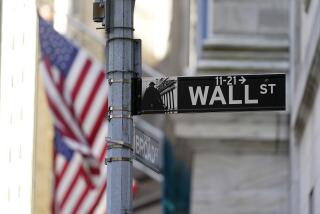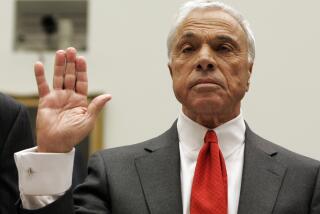Did Greenspan Set Off the Leverage Tripwire?
- Share via
NEW YORK — Nothing makes disaster more bearable than having someone to blame. As stock and bond managers took metaphorical plunges off Wall Street window ledges two weeks ago, they showered curses on the owlish head of Alan Greenspan, chairman of the Federal Reserve Board. Allegedly, by raising interest rates just the tiniest amount, Greenspan had touched a tripwire, that nudged over a domino, that blew open a dam, that wiped away a half-trillion dollars of the world’s paper wealth. The partial bounce-back last week hardly mollified tempers.
Falling markets are bad news for beleaguered President Bill Clinton as well, who crowed all last year about falling interest rates and rising stock prices. The Wall Street Journal, along with most other conservative pundits, refused to give Clinton any credit for last year’s booming markets, but leaped to point the finger at the White House two weeks ago. Consistency, after all, is the hobgoblin of small minds.
What did Greenspan do? The Federal Reserve lends money, mostly overnight, to banks. The rate the Fed charges to banks sets a floor on the rates that banks, in turn, charge their customers--for credit cards, for mortgages, for business loans. By pushing bank rates up a bit, the Fed hopes to slow the economy down a little, prevent inflationary overheating and keep the recovery going longer. Greenspan’s rate increases were truly small--a quarter of a percent in February, and another quarter of a percent in March. Since the previous rate, at 3%, was equivalent to zero interest after inflation, the increases hardly seem unreasonable--after all, why should banks get free loans from the taxpayer?
In truth, Greenspan is just a scapegoat. It is in the nature of markets to overshoot, and a large number of market professionals had begun to feel that the long bull market in stocks and bonds had pushed prices past the point justified by underlying values. The fact that market professionals reach a consensus doesn’t mean they’re right. But it does mean a lot of fund managers were ready to sell at the slightest sign of anything going wrong. And a number of special factors in our post-’80s, rocket-science-based markets can cause fierce short-term turnarounds.
The common man understands the magic of leverage. That’s why Californians made so much money in real estate for so many years. Buy a house for $100,000, but put up only $20,000 of your own. Sell the house for $120,000, pay off the $80,000 mortgage, and you have $40,000 left, doubling your investment.
Leverage works its magic in the financial markets too, but with a dangerous twist. If a fund manager buys stocks or bonds “on margin,” it means she has borrowed part of the purchase price. The lending institution keeps the stocks or bonds in its vault as security against the loan. But if the price of the securities falls, the fund manager must send the lender additional cash, so the loan is always 100% secure. This is a “margin call.” If there were margin calls in the housing market, the bank that held your mortgage would send you a bill for an immediate payment of $20,000 when the value of your house fell by that amount, so its mortgage loan would stay fully secured. Margin calls, obviously, can be nasty.
Professional managers can leverage the newest breed of financial instruments like index options and futures to extreme degrees, such as 50-1, even 100-1. When markets start falling, margin calls against such highly leveraged positions can set off a mad scramble for cash. In thin markets for unusual instruments, cash-desperate fund managers may find no buyers at any price. If Edgar Allen Poe’s Raven roosted on Wall Street, it would croak, “There are no bids.”
Something like this seems to have happened to Askin Capital Management, which trades in exotic instruments based on mortgage pools. Trapped with an illiquid portfolio and a crescendo of margin calls, they lost hundreds of millions of investor money almost overnight, wiping out their fund. Some of the big hedge funds, like George Soros’s, had also been forced into fire-sale liquidations to meet heavy margin calls, making managers everywhere nervous. It’s hard to blame all this on Greenspan.
Bondholders are natural melancholics--they like recessions, empty factories, bread lines. If the economy is slack, interest rates tend to be low, and low rates make bonds more valuable. (What is a bond worth that pays $5 of interest a year forever? If long-term interest rates are 10%, it is worth $50. But if rates are only 5%, it is $100. Bond prices go up when interest rates fall, and vice-versa. House prices work the same way.)
When voters were pummeling George Bush for the slow recovery in 1991 and 1992, bondholders were smiling smugly over in the corner. The economy was at a crawl, interest rates were falling and the value of their pile was going up by the day. Highly leveraged bondholders wore smiles that almost split their skin.
The Chinese puzzle of modern economics is that low, long-term interest rates mean happy bondholders; but low rates also spur growth and investment; but high growth frightens bondholders (for fear of inflation); frightened bondholders dump their bonds, so prices fall and rates rise; high rates choke off growth, so rates fall . . . And so on.
Much of so-called modern economic management is just crude psychologizing. Greenspan hopes that by raising short-term rates, bondholders will be convinced that the economy will not grow so fast as to ignite inflation, and therefore long-term rates will stay low. The bond managers clinging to skyscraper ledges are shouting he’ll produce the opposite result. Thomists and Occamites had these kind of arguments in the 14th Century.
In fact, Greenspan has little choice. After three full years of easy Fed credit, bank lending capacity has been rising fast. If banks suddenly converted all those potential loans into real loans, inflationary pressures really could increase. Keeping money super-cheap therefore makes little sense. What’s a fair rate to charge for overnight loans to healthy banks? Three-quarters of a percent more than inflation? One percent? If so, short-term rates have to go up again.
In a sensible world, such tiny moves shouldn’t make much difference, and over the medium-term, they probably won’t. The economy is in as good shape as it’s been in a while, and may even improve as Japan and Europe start to recover. The stock market pays extra returns because stocks are volatile. Investors with no stomach for daily ups and downs should keep their money in banks.
More to Read
Inside the business of entertainment
The Wide Shot brings you news, analysis and insights on everything from streaming wars to production — and what it all means for the future.
You may occasionally receive promotional content from the Los Angeles Times.










